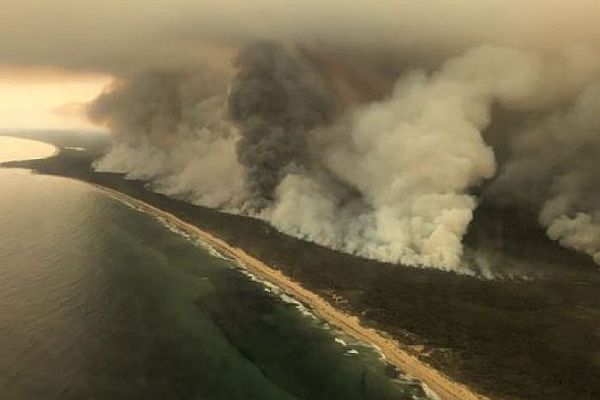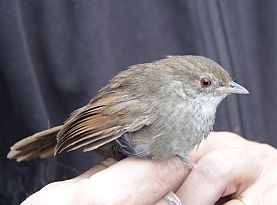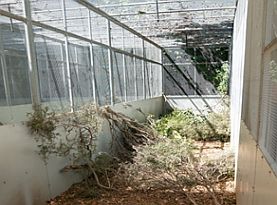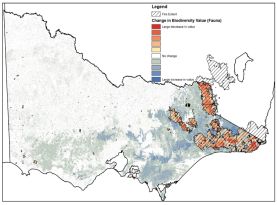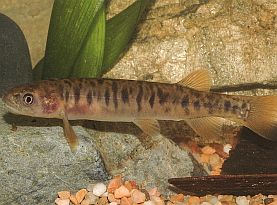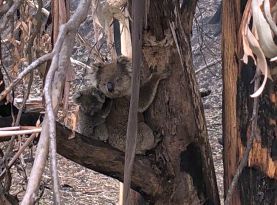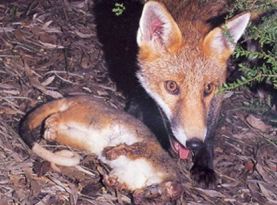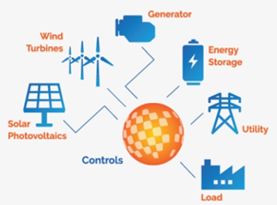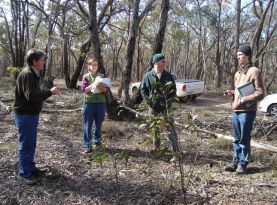SWIFFT Seminar notes 26 March 2020
Biodiversity emergency rescue and response after the January 2020 bushfires in Eastern Victoria
SWIFFT seminar notes are a summary of the seminar and not intended to be a definitive record of presentations made and issues discussed.
This SWIFFT seminar was conducted via Zoom with 249 online participants. SWIFFT wishes to acknowledge support from the Department of Environment, Land, Water and Planning, Victoria in organising the seminar. We thank speakers for their time and delivery of presentations. Thanks also to Michelle Butler who acknowledged traditional owners and chaired the session from Ballarat.
Key points summary
Eastern Bristlebird Emergency Rescue Project - DELWP
- January/February 2020 bushfires threatened the last remaining population of EBB's in Victoria.
- 15 EBB’s were rescued from the fire area as an insurance against the Victorian population becoming extinct.
Eastern Bristlebird Emergency Rescue Project - Zoos Victoria
- 15 rescued EBB’s were housed in secure facilities at Zoos Victoria.
- Up to 100 people were involved in preparing to house the bristlebirds at the Zoo.
- Seven birds were released back into their natural habitat on 1st April 2020.
Victoria’s bushfire emergency: Biodiversity response & recovery
- About 1.5 million ha was burnt in the 2019/20 fires in Eastern Victoria.
- Analysis of impacts on biodiversity is critical to response planning.
- The Strategic Biodiversity Response & Recovery identifies 12 hazards and 24 actions.
Post fire rescue of aquatic fauna
- Catchments in the fire area are the global centre for galaxiid diversity.
- Aquatic rescue must be done before rain washes sediments and ash into streams.
- Aquatic fauna salvage is an insurance policy against extinction.
- The Wildlife Welfare Response dealt with significant populations in targeted areas.
- A triage centre at Bairnsdale had an RSPCA mobile care unit with Veterinary support.
- A genetically significant Koala population at Gelantipy was translocated from burnt habitat.
Predator and herbivore control
- Control of pest predators and herbivores is focused on key habitats and native species impacted by fire.
- With limited on-ground access aerial shooting has proven to be very effective in controlling pest animals.
- A high priority within 0-6 months is to reduce the pressure deer are having on regenerating habitats.
- Regional Adaptation Strategies are being developed for each of the 6 regions in Victoria.
- Engaging with the community and having the community lead is critical to success.
- There are opportunities to develop renewable energy projects for communities in fire affected areas.
- There are a range of different applications and programs across Australia which people can use to submit observations.
- For Victoria, it is recommended to use iNaturalist.
- For experienced naturalists with good identification skills, species records can be added directly to the Victorian Biodiversity Atlas (VBA).
A key point common to each of the presenters was the incredible speed and collaboration shown across multiple agencies and the community in their response to dealing with the impacts on biodiversity from the fires.
List of topics and speakers
- Eastern Bristlebird Emergency Rescue Project - Mick Bramwell, Program Manager, Natural Environment Team, DELWP.
- Emergency rescue and housing of Eastern Bristlebirds at Zoos Victoria - Adam Lee – Zoos Victoria.
- Victoria’s bushfire emergency: Biodiversity response and recovery - Billy Geary, Senior Project Officer, Knowledge and Decision Systems, DELWP & Ella Kelly, Threatened Species Policy Officer, DELWP.
- Of Fire & Mud: post-fire extraction of threatened aquatic fauna 2020 - Tarmo A Raadik, Arthur Rylah Institute, DELWP.
- Wildlife Impacted by Fire – Field Assessments and Triage - Lachlan Clarke, Senior Wildlife Management Officer & Emily Cordy, Forest and Wildlife Officer (DELWP).
- Predator and herbivore control - Ben Fahey, Environment and Science, Parks Victoria & Damien McMaster - Biodiversity Division, DELWP.
- Climate change and fire recovery - Brian Thompson, Regional Manager, Hume Region, Community & Partnerships, DELWP & David Hood, Climate change Project Manager - Gippsland, DELWP
- Citizen Science - Andrew Geschke, Project Officer, Communication, Media and Engagement, Arthur Rylah Institute for Environmental Research.
Eastern Bristlebird Emergency Rescue Project
Mick Bramwell, Program Manager, Natural Environment Team, Department of Environment, Land, Water & Planning, Gippsland.
Overview of Eastern Bristlebird
Mick provided an overview of the Eastern Bristlebird as it is not a particularly well-known bird to most people in Victoria.
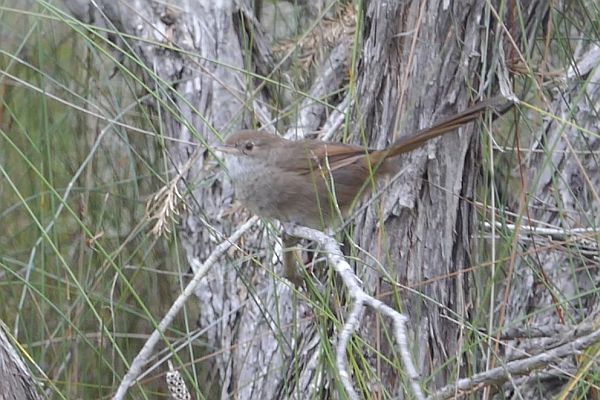
Population status
The Eastern Bristlebird is one of the 20 key species for national recovery. It is considered endangered in each of the three states where it occurs; about 50 birds in the border ranges area between New South Wales and Queensland, about 2000 birds at Barren Grounds and Jervis Bay in central NSW. There is a southern population in the Nadgee Nature Reserve in NSW bordering Victoria and about 140 – 160 birds in Victoria at Howe Flat near Mallacoota Inlet.
Habitat
In Victoria, habitat is restricted to wetter areas such as wet heathlands and riparian scrub. The bristlebirds are considered ‘cover dependent’ preferring dense vegetation cover often containing sedges with dense overstory.
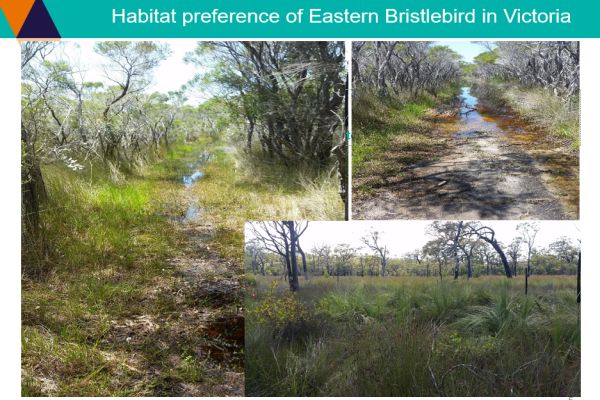
Eastern Bristlebird habitat can be very fire prone which means they are vulnerable to fire events; they are poor flyers with restricted dispersal.
Monitoring & management
There is one population of the Eastern Bristlebird in Victoria at Howe Flat. Extensions to the population were discovered in 2009 in heathlands to the north of Howe Flat and in 2018 to the east between the Nadgee population and Victorian population.
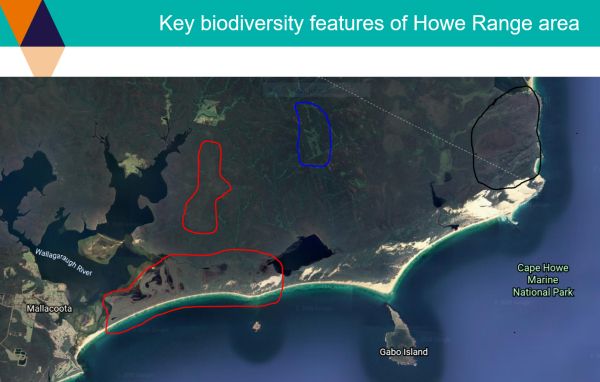
DELWP in conjunction with Parks Victoria and volunteer groups have been monitoring the Eastern Bristlebird in Victoria for over 20 years. Data indicates a slight increase in population.
Preferred management is the exclusion of planned fire in areas of occupancy until monitoring indicates a decline in the population.
East Gippsland Fire Progression 2019 - 2020
Mick spoke about the progression of fire in East Gippsland between 21 November 2019 and 21 January 2020 and highlighted out the run of fire on high risk days.
East Gippsland Fire Progression 2019 - 2020 Source: DELWP.
A focus of fire suppression was to keep fire out of an unburnt area in the Howe Range. The fire came within only a kilometer or two from Howe Flat which prompted the collection of some of the Eastern Bristlebirds as an insurance policy to capture some of the genetics of the population in case the fire destroyed the remaining Victorian population.
Mick showed a short video of the Eastern Bristlebird to remind us what all the effort was for. Footage courtesy of Mark Antos, Parks Victoria.
Emergency rescue planning and implementation
Mick discussed the setting up of a multi-agency task force that operated within the framework of the Orbost Incident Control Centre which provided good logistical support and fire protection support for field work.
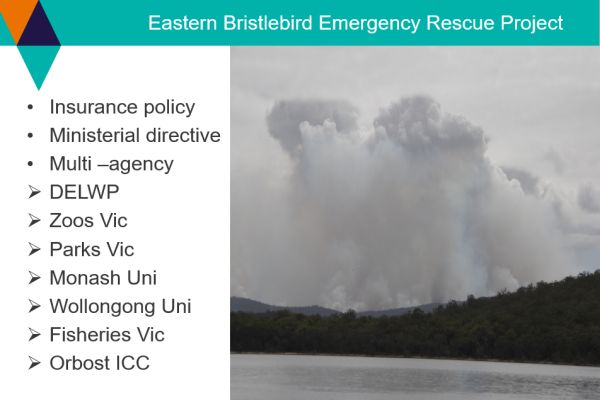

A field team briefing and strategy meeting was held at Marshmead (north of Howe Flat) to determine the capture and transport process.
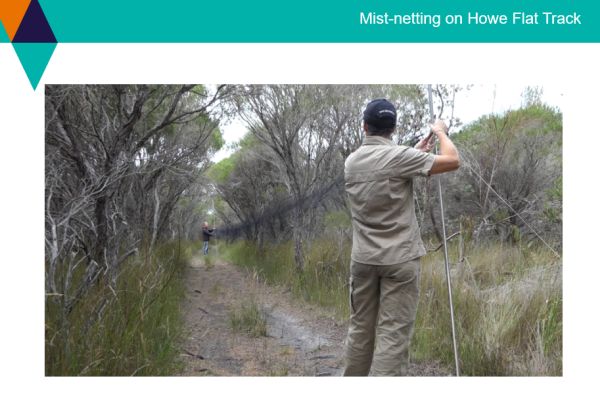
A total of 15 Eastern Bristlebirds were captured as part of the rescue.
The birds were banded, weighed and boxed ready for transport to Zoos Victoria which involved a boat trip across Mallacoota Inlet, a drive to the Mallacoota airport then a flight back to Melbourne and finally transport to Zoos Victoria.

Mick spoke about the urgency of the situation due to active fire behavior in the area. The team only had two days to complete the rescue because they were ordered to evacuate as it was expected the area would be burnt out.
Back to List of topics & speakers
Emergency rescue and housing of Eastern Bristlebirds at Zoos Victoria
Adam Lee – Zoos Victoria
Adam spoke about the captive husbandry planning and preparations involved in receiving the Eastern Bristlebirds at Zoos Victoria. Adam highlighted the tremendous collaborative effort in formulating the rescue plan and the incredible work that was achieved in a short timeframe to rescue the birds.
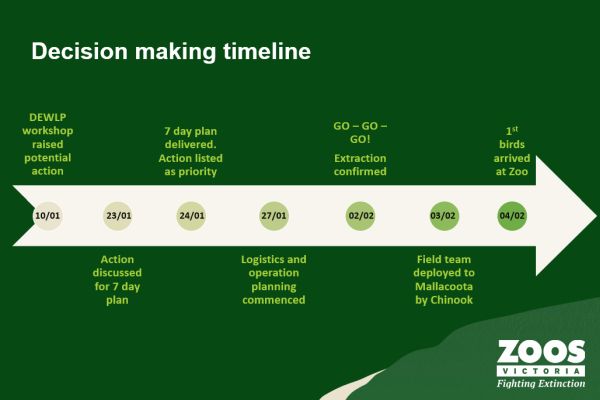
Zoos Victoria preparations
Adam spoke about some of the issues which had to be addressed so that Zoos Victoria could adequately receive and care for the rescued birds.
Permits to hold the birds were fast tracked.
Animal husbandry information specific to the Eastern Bristlebird was available through Currumbin Wildlife Sanctuary as they had previously kept Eastern Bristlebirds. Some staff from the Sanctuary also assisted in checking aviary design, husbandry and participated in the field work rescue.
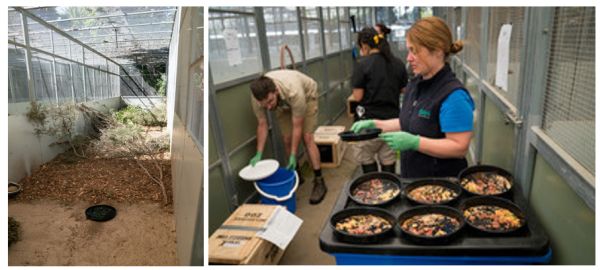
Specially designed transport boxes each with 370 pieces of material had to be made within 36 hours ready to be shipped to the rescue site.
Consideration of quarantine measures were undertaken to reduce the risk to both the existing Zoos Victoria collection and the rescued birds as these birds need to be returned to the wild disease free.
Challenges
Adam spoke about the high risk of the rescue effort given the fire activity in the area and the sensitivity of the birds. A number of risk assessments were carried out to ensure the survival of the birds from capture, during transport and housing at the Zoo ready for release back into the wild.
The Eastern Bristlebird is a sensitive, shy, cryptic species in captivity which presented additional challenges due to limited holding spaces at the Zoo. The bristlebirds are also a territorial species which meant DNA sexing was carried out to ensure males were not in the same aviary; birds were kept in pairs where possible.
Adam discussed a problem associated with Aspergillosis which is a fungus ubiquitous within the environment and common in wild birds. It can cause a severe pneumonia type illness in immuno-supressed birds, usually associated with birds which are subject to stress. Aspergillosis is difficult to treat and can cause a high mortality.
Preparing for release back into the wild
Adam outlined a process which included treatment regimes to ensure the birds would be fit for release (planned for early April 2020). After release, the bird's dispersal and survival will be monitored.
Genetic analysis will be undertaken to compare the southern population with the northern population.
Adam mentioned that the National Recovery Team will be reconvening which is a good step forward.
A special Eastern Bristlebird moment in the Zoo’s Victoria aviaries, a male calling and female calling back.
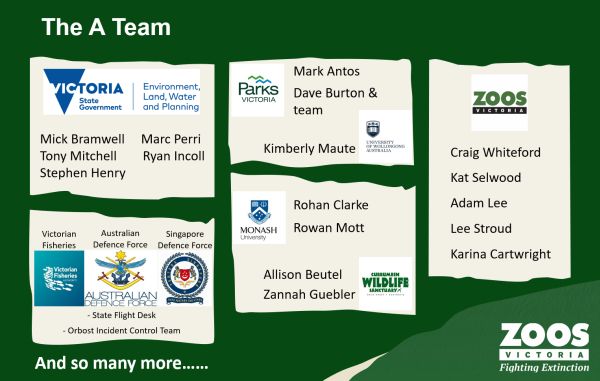
Victoria’s bushfire emergency: Biodiversity response and recovery
- Billy Geary, Senior Project Officer, Knowledge and Decision Systems, Biodiversity Division, DELWP.
- Ella Kelly, Threatened Species Policy Officer, DELWP.
Billy introduced his talk by discussing the work undertaken to prepare the Bushfire Biodiversity Response and Recovery Report which began in the first week of January. Since then, additional data has been collected and analysed which is being presented in Version 2 of the report.
Billy pointed out the capacity to undertake in-depth analysis so soon after the fires is largely due to the foundation work which has built up data sets over many years.
The total fire area from the December/January bushfires in East Victoria is around 1.5 million ha.
New information in version 2 of the report:
- Updated fire extent and inclusion of fire severity analysis
- Further data quality assurance to support improved assessment of impacts on species’ habitats
- Analysis of the impacts on invertebrate species (where data is available)
- Further information provided by species experts, land managers and other jurisdictions on vulnerability and impacts on important species populations or locations
- Information on actions to date
Version 2 of the report also includes:
- an increase from 17 to 20 species of fauna that had more than half of their modelled statewide distribution in the fire area.
- an increase from 168 to 222 species of flora that had more than half of their modelled statewide distribution in the fire area.
Version 1 of the report was prepared based on the fire area as at 11 January 2020. Version 2 of the report takes in an additional 200,000 ha of burnt area to 20 April 2020. See: DELWP biodiversity bushfire response & recovery.
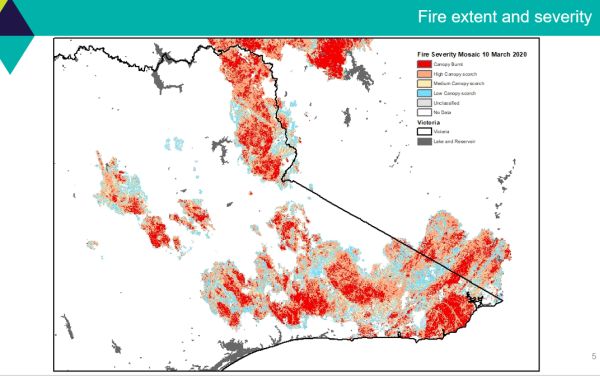
Fire extent and severity map. Map prepared with assistance of Forest Fire and Arthur Rylah Institute.
(Red) - canopy burnt, (orange) – high canopy scorch, (cream) – medium canopy scorch, (blue) – low canopy scorch.
Broad species impacts
Billy spoke about a number of tables which showed analysis of species impacted by area burnt from Version 2 of the report.
- 4 species of fauna had over 95% of their modelled habitat in the fire area
- 13 species of flora had over 95% of their modelled habitat in the fire area
- 130 species of fauna had 10-30% of modelled habitat in the fire area
- 925 species of flora had 10-30% of modelled habitat in the fire area
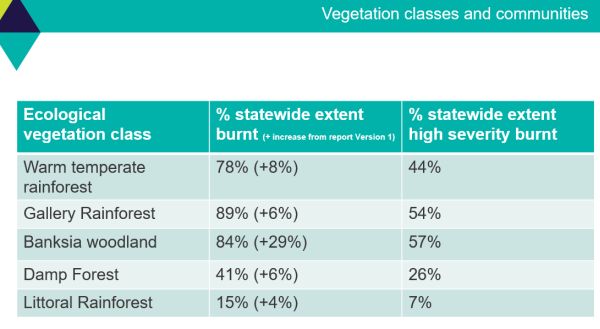
Sever impacts on Warm Temperate Rainforest, Gallery Rainforest and Banksia Woodland which had a 29% increase in area burnt between 11 January and 4 March 2020.
Case studies
Fauna species with % of modelled habitat in fire area
A number of case studies now include additional information from local knowledge:
- Brush-tailed Rock-Wallaby 42%
- Long-footed Potoroo 79%
- Spotted Tree Frog 22%
- Freshwater fish up to 100%
- Diamond Python 86%
- Large Brown Tree Frog 87%
Assessment post fire combined with local knowledge has been valuable in quantifying the impacts.
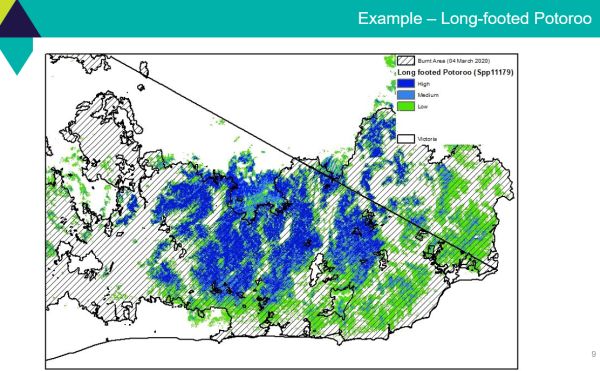
Example of habitat distribution model combined with fire area for Long-footed Potoroo.
(Blue) - high likelihood of good habitat; (green) – low likelihood of good habitat; (hatched) - burnt area.
Calculating the proportion of state-wide habitat burnt for a species is done by calculating the amount of habitat within the burnt area and dividing by the habitat for the species across the state.
Flora species with % of modelled habitat in fire area:
- Betka Bottlebrush 93%
- Buff Hazelwood 47%
- Alpine Ash 24%
- Summer Leak Orchid 49%.
For Alpine Ash, young Ash (aged around 20 years or less) are particularly vulnerable to fire. Initial analyses suggest at least 52,000 ha of Alpine Ash have been impacted in the 2019/2020 bushfires, and over 20,000 ha of this are young stands which will not regenerate.
Multiple recent fires
Billy discussed the issue of multiple fires in the same area of forest 2, 3 or 4 times in the last 20 years. For example, there has been an almost a doubling of the amount of area that has been burnt twice since 2000. He also pointed out that about 14,000 ha of Alpine Ash has been burnt multiple times in the last few years.
Change in (short term) biodiversity value
Billy spoke about some recent modelling with the assistance of ARI which looked at identifying areas outside the fire area which have become more important as a result of the fires. This is valuable information for managing species that have lost important habitat due to the fires by identifying and recognising the value of habitat outside the fire area for conservation action.
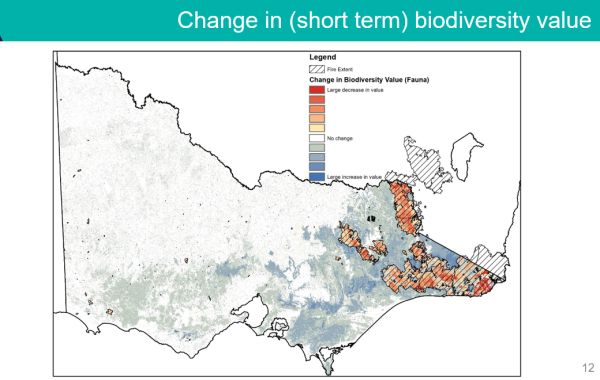
Response and Recovery Plan
-Ella Kelly - Threatened Species Policy Officer, DELWP.
Ella provided an overview of the strategic biodiversity response and recovery in Victoria. The aim of the overarching strategy is to ensure co-ordination between different emergency response recommendations and multiple funding sources.
The strategy takes a hazard-based approach looking at the immediate impacts of fire as well as on-going threats. At present 12 hazards have been identified which leads to 24 actions. The strategy will be implemented across different time frames. Phase 1 – Immediate & short term (up to 1-year post fire); Phase 2 - Medium term (1-3 years post fire); Phase 3 – Long-term.
Ella pointed out that under climate change we have entered a changed environment where multiple large-scale fires are now increasing in frequency so actions need to consider future threats both within and outside the current fire area.
Ella spoke about the immediate and short-term recovery actions, Phase 1 which has received $17.5 million funding via the Victorian State Government. Six main themes have been identified for action. Ella pointed out prioritisation of recovery actions is essential due to limits in available time and resources.
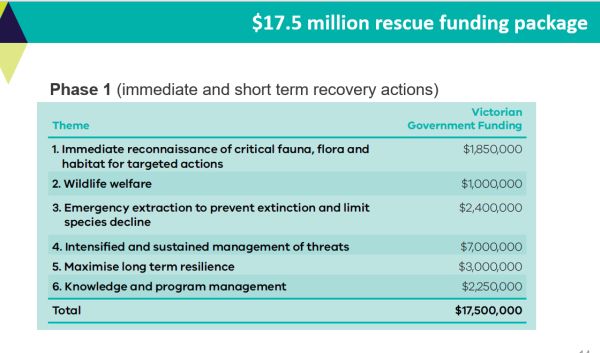
Actions already underway
- Protection of key unburnt areas
- Immediate reconnaissance of critical species to inform status following fire (including aerial and on-ground assessments)
- Emergency extraction and temporary housing of critical flora and fauna species
- Intensified and sustained pest predator and herbivore
More actions will be added as access to the fire grounds becomes more feasible.
Contact: Billy Geary or Ella Kelly
DELWP biodiversity bushfire response & recovery
Back to List of topics & speakers
Of Fire & Mud: post-fire extraction of threatened aquatic fauna 2020
Tarmo A Raadik
Tarmo and the aquatic species rescue team started undertaking emergency rescue of aquatic species in early February 2020, at a time when the bushfire situation was still active in eastern Victoria. Tarmo stressed the importance of undertaking the rescue before significant rains occurred as run-off containing sediments and ash would quickly ruin stream habitat. Unfortunately, not all rescue operations could be completed before heavy rainfall fell, severely damaging a significant number of streams and their instream habitat.
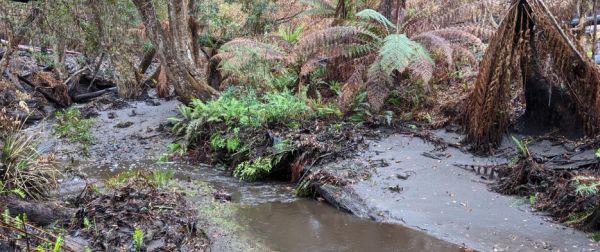
The focus area for Tarmo’s talk was the coastal east Gippsland area from the upper Dargo River to Mallacoota. Tarmo pointed out the catchments in this area are the global centre for galaxiid diversity. The area is also a National diversity hot spot for freshwater crayfish.
Tarmo spoke about fire intensity mapping which is very useful for understanding what the impacts might be on a stream from further up the catchment. The greater fire intensity the more likelihood of severe runoff containing ash and sediments which will impact on the entire system.
Threatened aquatic species rescue
The concept behind emergency rescue is to take a portion of the threatened aquatic species out of the disturbed catchment until the threat passes. This must be done as soon as possible after the fire. Rescued aquatic animals are kept in secure aquarium facilities and returned to the stream when the natural system can support them. The rescue is an insurance against a species becoming extinct, particularly as many of the species are restricted in their distribution and susceptible to being wiped out by a single catastrophic event.
Tarmo A Raadik explains the aquatic rescue operation undertaken to save aquatic species as a result of the 2020 East Gippsland bushfires. Source: DELWP.
Target aquatic species
Tarmo spoke about those species which are considered threatened, species with limited distribution and those with a high percentage of their distribution impacted by the fire.
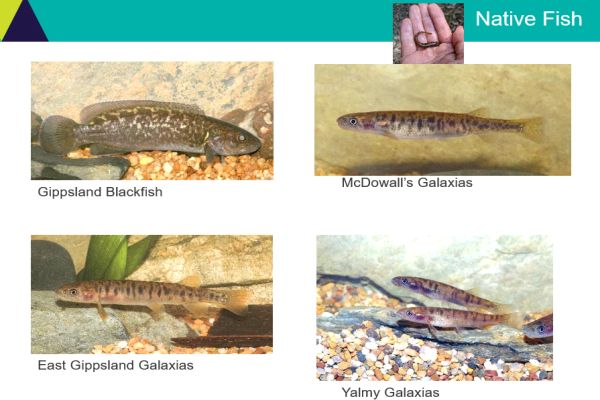
Other species of fish include some species which have not yet been formally described as new species;
- Dargo Galaxias
- Galaxias sp. 17 ‘Cann’ Galaxias
- Roundsnout Galaxias
- Galaxias olidus complex
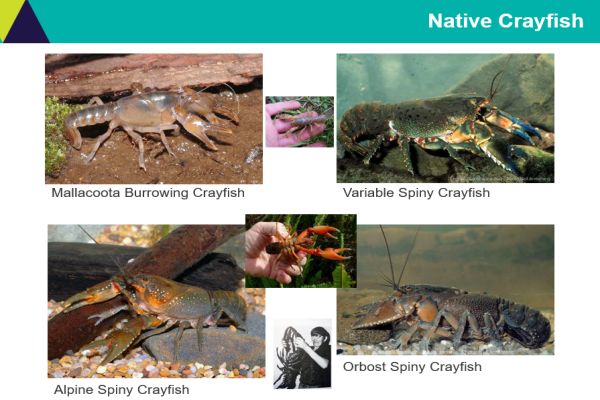
Other species of Freshwater crayfish include;
- East Gippsland Spiny Crayfish
- Euastacus sp. 1 Arte Spiny Crayfish
- Euastacus sp. 2 Cann Spiny Crayfish
- Euastacus sp. 3 Snowy Spiny Crayfish
Two species of Freshwater Mussel were part of the rescue;
- Depressed River Mussel
- Austral River Mussel
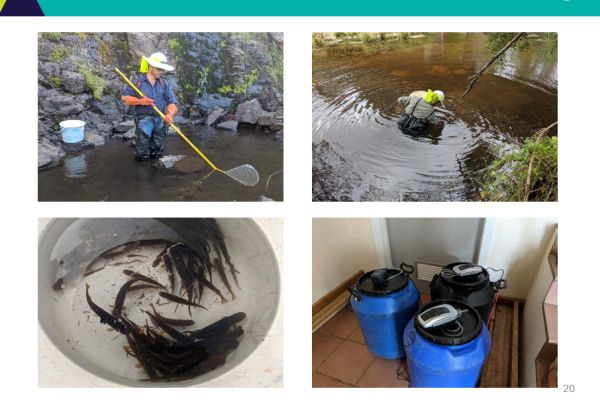
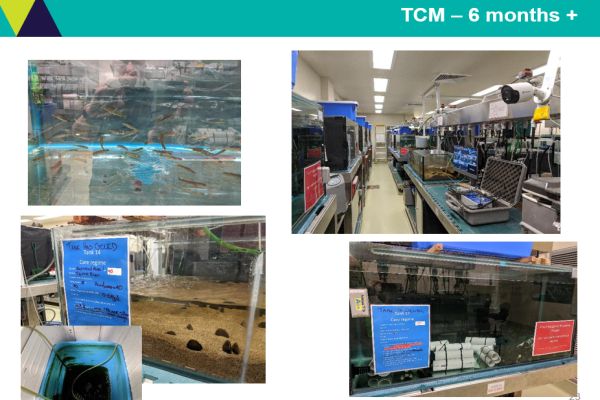
Tarmo spoke about how previous rounds of Victorian and Federal government threatened species funding had underpinned the success of the rescue by knowing in which streams the various species were located. Previous threated species funding also meant facilities and expertise for holding aquatic species at ARI were already in place and could be quickly be swung into action for this rescue effort.
Collaborators
- DELWP-ARI field team: Michael Nicol, Daniel Stoessel, James Shelley
- DELWP Biodiversity Division: James Todd, Adrian Moorrees, Sheri Burmeister, Jeremy Hindell
- DELWP-Gippsland: Stephen Henry, Marc Perri, Orbost ICC
- Parks Victoria: Mark Norman, Dave Burton, Phil Mehlert
- Darryl Whitaker (videographer)
Key points from questions
It was not possible to gain access to all the known sites due to the fires, remoteness of the areas and hazards. Tarmo indicated there are some special sites containing critically endangered species which still require surveys but if the in-stream sedimentation is severe there is a possibility the populations could be heavily depleted or even extinct.
The aquarium facility at ARI is closely managed with restriction on entry. Due to Covid 19 rosters are in place to ensure the collection is properly maintained.
Back to List of topics & speakers
Wildlife Impacted by fire – Field Assessments and Triage
Lachlan Clarke – Senior Wildlife Management Officer & Emily Cordy – Forest and Wildlife Officer (DELWP)
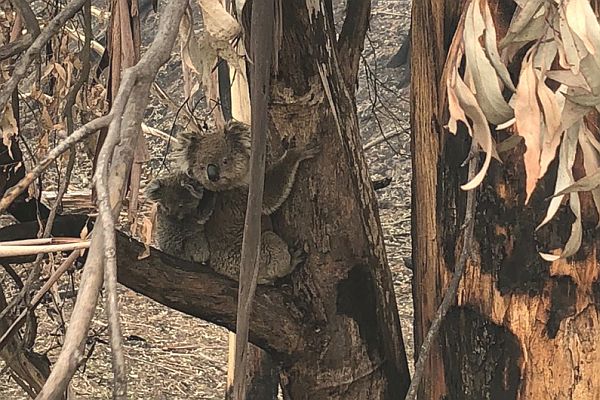
Emily spoke about the Wildlife Welfare Response which was set up around the 5th of January 2020. Wildlife response coordinators were appointed to coordinate multiple crews conducting daily wildlife assessments. In East Gippsland, bases were set up at Orbost and Bairnsdale. Field crews would go out into the fire area and look at the behaviour of animals, their movement, interactions and assess the condition of animals. If an animal was in need of help the crew would collect the animal and take it back to a wildlife triage centre. Emily pointed out training had been given to wildlife handlers to ensure their safety and operate causing minimal distress to the animal.
The triage centre at Bairnsdale had an RSPCA mobile care unit with Veterinarian and Vet nurses.
Wildlife record keeping
Field crews collected information on when and where they were operating together with field observations which would become valuable information used to plan operations and ensure resources were deployed to priority areas.
Animal rescue record
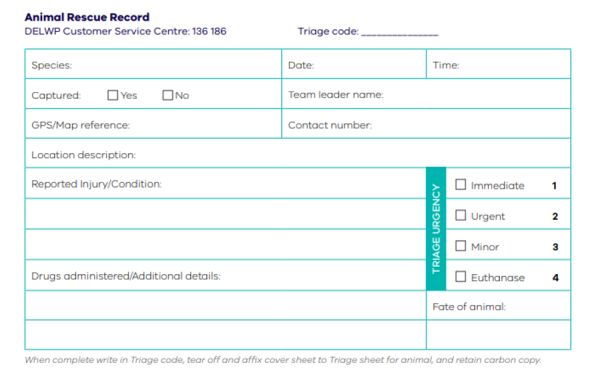
Lachlan Clarke – Senior Wildlife Management Officer
Lachlan spoke about the need for a structured approach in dealing with wildlife welfare response. Data sources such as the Victorian Biodiversity Atlas together with information from local experts helped determine where the response effort should be targeted.
A genetically significant Koala population at Gelantipy was identified as being a priority. Field assessments found the fire had impacted at various levels of intensity through the habitat but thankfully it had not completely wiped out the population.
The health of the Koalas was monitored, where required the koalas were caught, taken to vets for treatment, held for rehabilitation and care then released at a new location which contained suitable unburnt habitat nearby. Two release sites were chosen as an insurance against the possibility that the release site could be burnt.
Some of the Koalas in longer term care will be released back to the original site when the forest has adequately recovered.
Monitoring of the Koala populations will be carried out in the short and long-term. Already there are signs the vegetation in the burnt area is coming back and the Koalas are looking in good condition. Koalas in the translocation sites are also doing well.
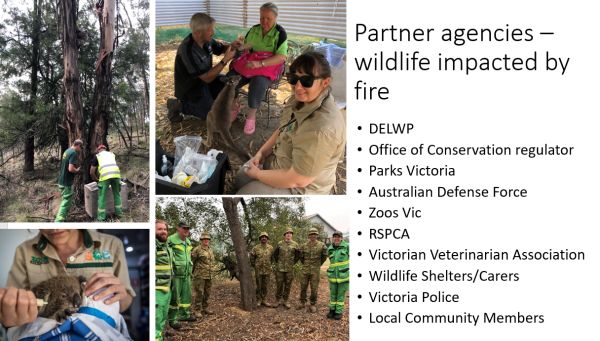
Wildlife Triage Centre
Lachlan provided a brief overview of the support and effort involved in caring for injured wildlife. The RSPCA Mobile Animal Care Unit was present, managed by vets and vet nurses from Zoos Victoria and Australian Veterinary Association (AVA). This enabled specialised wildlife assessment and treatment to be undertaken.
Leanne Wicker from Zoos Victoria will provide a further presentation on the details of Wildlife Triage at a future SWIFFT seminar.
Key points from questions
The translocation of koalas to a nearby location was undertaken within the dynamics of the fire situation. There was a possibility that many of the koalas would die if they were not relocated.
There is an established relationship between the indigenous people of Gippsland and koala management activities including the koala relocation response at Gelantipy.
The Wildlife Welfare Response was focused on large landscape scale populations, particularly significant populations targeted in areas where there could be successful outcomes.
Back to List of topics & speakers
Intensified and sustained management of threats - predator and herbivore control
Ben Fahey – Environment and Science, Parks Victoria and Damien McMaster - Biodiversity Division, DELWP
Ben introduced the presentation by explaining the project is implementing Actions in Phase 1 (0 – 6 months post fire) of the Strategic Biodiversity Response and Recovery Plan, Theme: Intensified and sustained management of threats.
Co-leaders of the project are; Ben Fahey (Parks Victoria), Kate McArthur (Biodiversity Division, DELWP) and Damien McMaster (Biodiversity Division, DELWP). The team is currently working with the regional delivery partners to develop a plan for projects under this theme.
The plan is to focus on key habitats and species impacted by fire and develop activities to reduce the overall grazing pressure from introduced herbivores on those areas along with reducing direct impacts from pest predators.
Invasive species pose a considerable threat to native species recovering from fire. Ben spoke about work undertaken to identify key areas of unburnt habitat where feral animals such as pigs, deer, goats and cats are congregating.

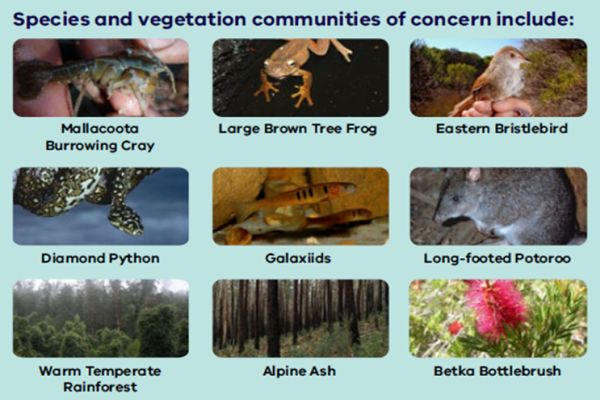
Predator control
Foxes and feral cats have been identified as key predators. Activities to mitigate the impacts from these species include; re-establishment and expansion of existing landscape scale fox baiting programs such as Southern Ark and the Barry Mountains fox program.
Herbivore control
The number one priority at present is to reduce the pressure deer are having on regenerating habitats.
Emergency response actions
Damien McMaster spoke about 'pest animal control' being identified as an immediate priority action. After the fire there is a critical window of opportunity for management efficiency and effectiveness when public land is closed, canopy and ground cover is reduced and the target pest species are congregating around limited resources (shelter, food, water) and are yet to disperse across the landscape.
Aerial shooting operations
With limited on-ground access, aerial shooting has proven to be very effective in controlling pest animals. Aerial shooting operations are coordinated through the State Control Centre with a specialised taskforce operating out of the local Incident Control Centres. The highest priority is on safety and compliance.
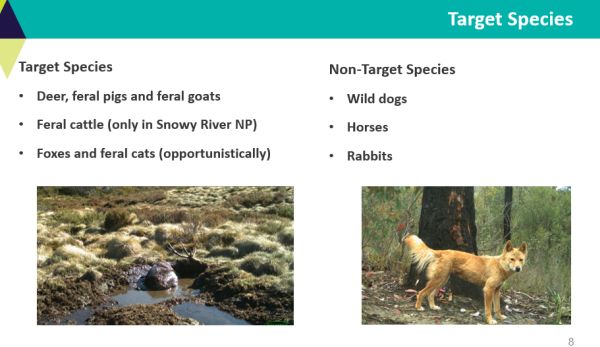
Mapping priority areas for treatment
Damian reiterated some of the points made by Ben Faye in regard to the planning and collection of a considerable amount of information to determine priority areas. The team used the Strategic Management Prospects (SMP) which is a tool used to develop threat models, the benefit of action and the most cost-effective actions to protect the greatest amount of biodiversity values. Mapping priority areas also had to account for legal requirements for operating across land tenure, as well as government policy position for the management of pest species. Safety of the public and firefighters is paramount in planning operations.
Priority areas
The immediate priority locations were based on the protection of critical at risk species and communities, these include:
- Alpine peatlands across Mt Buffalo and Alpine National Park.
- Warm, cool and littoral rainforest areas throughout East Gippsland including those within the Snowy National Park and the coastal areas from cape Conran to Cape Howe, including Croajinalong National Park and the Cape Howe Wilderness area.
- The Upper Murray area including Mt Mittamatite and Burrowa Pine Mountain are also a priority area for the protection of the black pine species.
Progress of aerial operations
Operations commenced on 10 February 2020 within Mount Buffalo, Alpine and Snowy River and Croajingolong National Parks. After six weeks there had been 23 operational days with 36 individual missions.
Native species observed include kangaroos, wallabies, dingoes, wombats and many bird species.
Non-target pest species observed >100 feral horses particular within the eastern Alps of the Alpine National Park and rabbits.
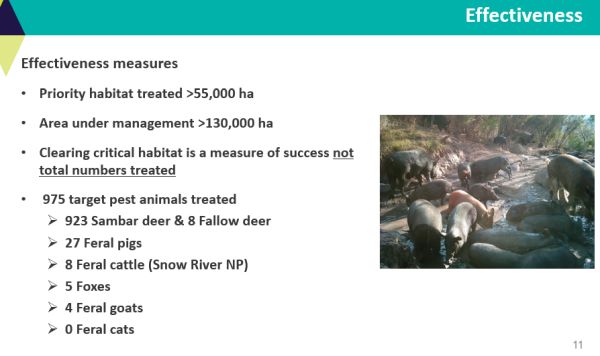
There has been a 93% efficiency of the aerial shooting team which means 93% of all the target pest animals observed have been cleared from the area. Animals near watercourses and walking tracks are outside the engagement area which can limit the efficiency.
The current aerial shooting operations are planned to continue until 30 April 2020. The program will transition into sustained control with Parks Victoria being the lead agency to ensure long-term recovery and biodiversity outcomes within priority locations.
Damian stressed the program is very much a collaborative approach from all agencies including DELWP biodiversity, Forest Fire Management, Natural Environment Program as well as Parks Victoria and CFA.
Key points from questions
Control of feral horses are not part of the aerial shooting program. The control of feral horses in Victoria's National Parks is undertaken by trapping. Different states around Australia have different approaches in deling with feral horses.
A number of reconnisance flights have taken place after the fires to locate impacts from feral horses in the Alpine National Parks, particularly looking at damage to peatland habitat.
Back to List of topics & speakers
Climate change and fire recovery
Brian Thompson, Regional Manager- Hume region, Community & Partnerships, DELWP
David Hood, Climate Change Project Manager - Gippsland, DELWP
Brian spoke about the fact that the 2020 bushfires have been a real wakeup call regarding climate change to the community. He highlighted Victoria’s Climate Change Act 2017 with a target of net zero emissions by 2050 and interim 5-year targets. The Act also makes provision for developing Regional Adaptation Strategies.
Regional Adaptation Strategies
There are 6 regional strategies being developed in Victoria. Each region is embarking on the process to suit their regional communities. A key part of the strategy will be engaging with the community and having the community lead rather than having a top down approach.
There will be multiple approaches to suite different demographics, communities and industry with a focus on supporting actions. Brian felt the key to success is to find people who want to do something, help them do it and learn together.
Gippsland Regional Engagement – Climate Change
David spoke about the development of community engagement in the Gippsland region which began with consultants going out to the community to do survey work on community views on climate change and renewable energy. It was found there was a high level of awareness and support for renewable energy in the Gippsland region. There was a proportion of scepticism about climate change and the shift to renewables with concerns about potential impacts of renewables on residents, communities and the landscape.
David thought there is an opportunity to educate the community about some of the less well-known forms of renewables.
Engagement activities included youth engagement through a Broadening Horizons Program in Gippsland. The program incorporates about 19 schools in the region. A renewable energy trailer has been set up for use at schools and sustainability festivals.
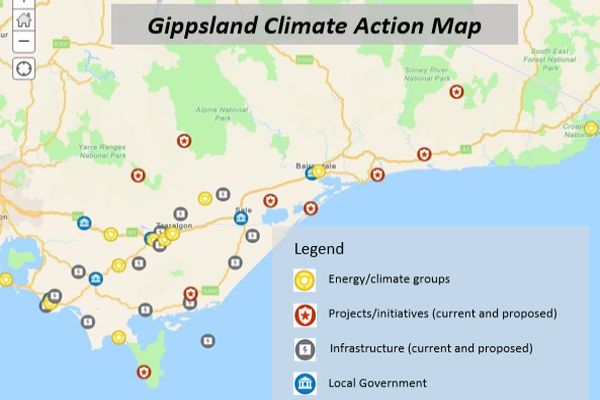
Renewable energy in fire affected areas
David spoke of the need to be respectful and mindful of what has unfolded in fire affected communities over the summer. It is important to find out what the community wants out of the process. There has been some work undertaken by Local Government Authorities (LGA's) in Gippsland regarding the assessment of risks to infrastructure which is helpful in identifying threats and future priorities.
Brian spoke about opportunities which have arisen because of the fires to make improvements on what existed in the past, for example:
- Microgrids – the community generates and shares power (solar/wind). The microgrid can be connected to the grid but can stand alone when the power goes down. At present microgrids are small scale with only a few buildings but there is an opportunity to step up the concept to town level.
- Stand-alone power systems – similar to microgrids but not connected to the grid.
- Resilient hubs – existing community hubs for support services to be enhanced with renewable energy.
- Rebuild – where homes and business have been burnt create packages to support the rebuild with renewables.
Climate Ready Hume
Brian spoke about the Hume Regional Adaptation Strategy.
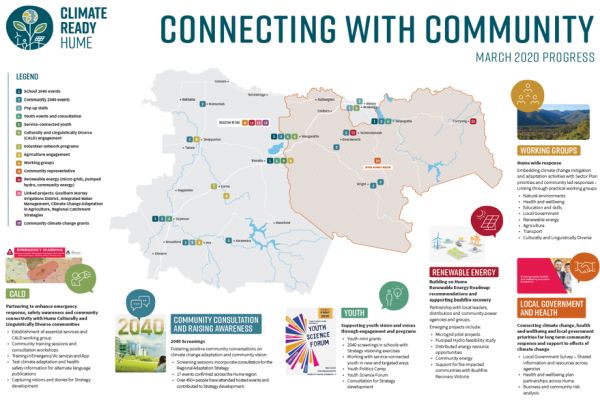
Map of Hume community engagement projects. Even with COVID-19 social distancing there will still be other ways of undertaking community engagement. Some of the projects include;
- Culturally Linguistic Diverse Communities (CALD)
- Screening of the film 2040 (450 people have already seen the movies in the Hume Region).
- Youth Science Forum
- Renewable Energy
- Local Government & Health
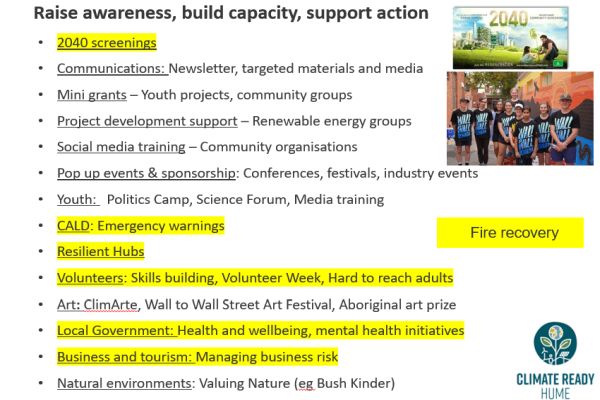
Furher information on DELWP Hume and Gippsland regional climate change projects please contact
Kristy Roche, Project Manager - Hume, 0436 688 298
David Hood, Project Manager - Gippsland, 0436 648 771
Back to List of topics & speakers
Citizen Science
Andrew Geschke, Project Officer- Communication, Media and Engagement, Arthur Rylah Institute for Environmental Research.
The overall program for contributing information concerning biodiversity and the fires in Victoria is called ‘Data for wildlife’. A range of different applications and programs are available across Australia which people can use to submit observations. For Victoria, it is recommended to use iNaturalist which has a section for the Australian bushfires 2019/20. For experienced naturalists with good identification skills, species records can be added directly to the Victorian Biodiversity Atlas (VBA).
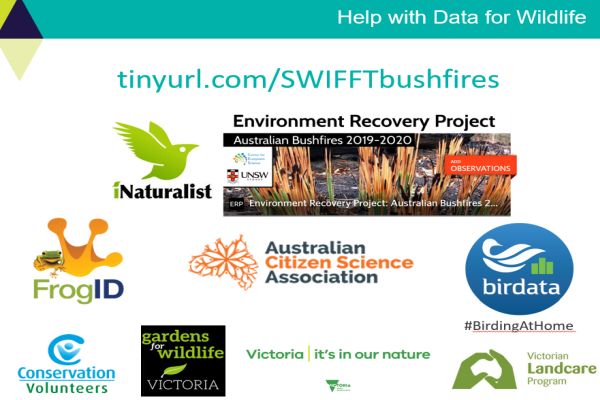
When people are able to get out into the bushlands again and record their sighting after COVID-19 shutdown the data collected will be valuable in understanding the trajectory of recovery post fire.
SWIFFT January 2020 bushfires and biodiversity lists relevant web sites and resources.
SWIFFT Seminar Notes: Fire Recovery and Citizen Science 25 March 2021
Health and wellbeing

Back to List of topics & speakers
See also:
Bushfire Recovery - community wildlife reporting
Members across the community are asked to report sightings of six key species within fire-affected (and neighbouring) areas;
- Glossy Black Cockatoo / Calyptorhynchus lathami
- Eastern Ground Parrot /Pezoporus wallicus
- Diamond Python / Morelia spilota
- Spot-tailed Quoll / Dasyurus maculatus
- Lace Monitor / Tree Goanna /Varanus varius
- Koala / Phascolarctos cinereus
Robley, A., Cally, J.G., Murray, A., Bluff, L., Collyer, A., Borg, N. and Phillips, L. (2022). The response of native species to the 2019–20 bushfires and introduced predators in far East Gippsland. Arthur Rylah Institute for Environmental Research Technical Report Series No. 329. Department of Environment, Land, Water and Planning, Heidelberg, Victoria. View Report


